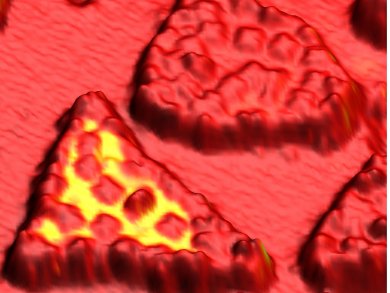Electronic components the size of individual molecules are needed for the continued miniaturization of computers and other devices. Wulf Wulfhekel and colleagues, Karlsruhe Institute of Technology (KIT), Germany, have succeeded for the first time in combining spin electronics and molecular electronics in a component consisting of a single molecule. The organic molecule used, H2-phthalocyanin, was shown to have a strong dependence of its resistance with applied magnetic field, making it the smallest magnetic field sensor yet discovered.
Miniaturization is associated with the problem of the information being encoded in the charge of the electron (current on or off). This requires a relatively high amount of energy. In spin electronics, the information is encoded in the electron’s spin. As the spin is maintained even when the current is off, this could let components store information without any energy consumption.
Image: Scanning tunneling microscopy image of H2-phthalocyanin.
Coloring indicates variable spin orientation. (C) KIT Center for Functional Nanostructures
- Giant magnetoresistance through a single molecule
S. Schmaus, A. Bagrets, Y. Nahas, T. K. Yamada, A. Bork, M. Bowen, E. Beaurepaire, F. Evers, W. Wulfhekel,
Nat. Nanotechnol. 2011, 6, 185–189.
DOI: 10.1038/nnano.2011.11




